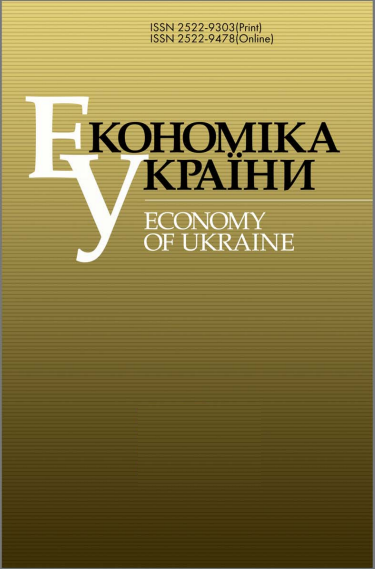FISCAL POLICY OF CONTEMPORARY CHINA: GLOBAL AND LOCAL CHALLENGES
DOI:
https://doi.org/10.15407/economyukr.2025.01.055Keywords:
fiscal policy; geoeconomic fragmentation; demographic transition; Chinese economy; public finances.Abstract
The fiscal policy of contemporary China is aimed at supporting the shift from "high-rate economic growth" to "high-quality economic growth", which involves the formation of new productive forces. However, the intensifying geoeconomic fragmentation, the decoupling of the Chinese and US economies, the demographic transition and the growth of the debt burden are becoming challenges to the country's public finances resilience.
The features and measures of China’s current fiscal policy in the context of the aggravation of global economic confrontation are identified, the need for fiscal adjustment to overcome internal macroeconomic and fiscal imbalances is argued. The dynamics and structure of revenues and expenditures of budgets of various levels in the PRC over the past decade are analyzed, the factors of their change are identified; the factors affecting the current state of PRC public finances are systematized and their analytical assessment is carried out. It is shown that the challenges of technological decoupling and macroeconomic imbalances cause the revenue pressure on budgets of various levels.
Demographic challenges caused by the increase in Chinese population’s longevity, the decline in the birth rate and population ageing put pressure on government expenditures and will cause its growth in the medium term. A significant challenge to China's public finances resilience is the increase in local debt, including due to the growth of implicit debts of local government financing vehicles. To stimulate "high-quality economic growth" in China, measures have been taken to impose a tax burden on business entities. The expansion of fiscal space is carried out by issuing ultra-long special treasury bonds, the proceeds of which will be used to finance projects, including in the field of high-tech production. It is concluded that China's fiscal policy is adapting to the new economic reality and ensuring the formation of a new type of economic growth. However, finding a balance between stimulating further growth of Chinese economy in the face of global and local challenges and maintaining fiscal resilience is becoming the main task of China's fiscal policy for the future.
References
Farrell, H., Newman, A. (2023). The New Economic Security State. How De-risking Will Remake Geopolitics. Foreign Affairs. Vol. 102. No. 6. P. 106-122. URL: https://www.foreignaffairs.com/united-states/economic-security-state-farrell-newman
Medeiros, E. (2024). The Delusion of Peak China. Foreign Affairs. Vol. 103. No. 6. P. 40-49. URL: https://www.foreignaffairs.com/china/delusion-peak-china-united-states-evan-medeiros
Liang, Yan (2024). China's economy is resilient and dynamic. China Social Sciences Network –– China Social Sciences Today. URL: https://www.cssn.cn/skgz/bwyc/202403/t20240318_5738859.shtml [in Chinese].
Prasad, E. (2023). Has China’s growth gone from miracle to malady? National Bureau of Economic Research. Working Paper Series. No. 31151. https://doi.org/10.3386/w31151
Arpaia, A. Turrini, A. (2008). Government expenditure and economic growth in the EU: long-run tendencies and short-term adjustment. Economic Papers. No. 300. February. https://doi.org/10.2139/ssrn.1097286
Shi, D., Zhang, Q., Guo, Ch. (2024). New Milestone Achievements in China’s Industrial Transformation and Upgrading. China Economist. Vol. 19. No. 2. P. 16-30. URL: http://www.chinaeconomist.com/pdf/2024/2024-2/Research%20Group%20of%20the%20Institute%20of%20Industrial%20Economics.pdf
Stepanova, O. (2018). The longevity economy and new projections of PRC economic development. Ukraine-China. No. 13. P. 114-120. URL: https://sinologist.com.ua/stepanova-o-v-ekonomika-dovgolittya-ta-novi-proektsiyi-ekonomichnogo-rozvytku-knr/ [in Ukrainian].
Yi, Zh., Sanjay, K., Xianhai, H. (2023). Human capital quality and the regional economic growth: Evidence from China. Journal of Asian Economics. Vol. 86. P. 1-27. https://doi.org/10.1016/j.asieco.2023.101593
Dechun, L., Xinye, Zh., Yihua, Y. (2022). Public Debt Competition in Local China: Evidence and Mechanism of Spatial Interactions. Regional Science Policy & Practice. Vol. 14. Supplement 2. P. 91-106. https://doi.org/10.1111/rsp3.12509
Ning, H., Huiyan, G., Weitao, D. (2024). Spatial Interaction of Local Government Debt: Evidence from China. Sustainability. No. 16. P. 1-27. https://doi.org/10.3390/su16083482
Kim, J., Wang, M., Park, D., Petalcorin, C. (2021). Fiscal policy and economic growth: some evidence from China. Review of World Economics. Vol. 157. No. 3. P. 555-582. https://doi.org/10.1007/s10290-021-00414-5
Downloads
Published
How to Cite
Issue
Section
License
Copyright (c) 2025 Publisher PH «Akademperiodyka»

This work is licensed under a Creative Commons Attribution-NonCommercial-NoDerivatives 4.0 International License.



